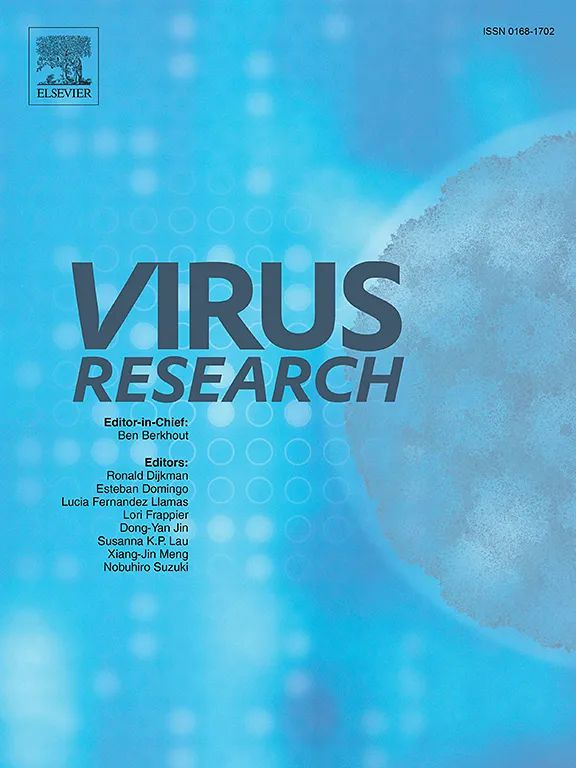5,6-dihydroxyflavone exerts anti-betacoronavirus activity by blocking viral entry to host cells
IF 2.7
4区 医学
Q3 VIROLOGY
引用次数: 0
Abstract
Baicalin, a bioactive flavone found in Scutellaria baicalensis Georgi has anti-SARS-CoV-2 infection by targeting viral 3C-like protease (3CLpro). However, little is known about the antiviral activity of its 7-deoxy analogue, 5,6-dihydroxyflavone (5,6-DHF), especially against betacoronaviruses (beta-CoVs). We found that 5,6-DHF exhibited more potent anti-SARS-CoV-2 Omicron variant EG.5.1.1 activity than baicalein by microneutralization test (MNT) and plaque reduction neutralization test (PRNT). 5,6-Dihydroxyl (catechol) groups at A ring of 5,6-DHF is essential for its suppression on SARS-CoV-2 Omicron variant EG.5.1.1 infection because blocking them with methyl or methylene groups obsolesce the activity. 3CLpro inhibition assay showed that the antiviral activity of 5,6-DHF is distinctive with baicalein. Time of addition test, molecular docking and spike-bearing pseudotyped virus entry assay suggested that 5,6-DHF interferes the spike-ACE2 interaction by targeting at receptor binding domain (RBD) of spike and hence inhibits the virus replication. In addition to SARS-CoV-2 Omicron variant EG.5.1.1, 5,6-DHF was also found effective against another common human beta-CoVs, HCoV-OC43, by blocking their entry to host cells. Taken together, the present study demonstrated the potential function of 5,6-DHF as a therapeutic candidate against beta-CoVs.
5,6-二羟黄酮通过阻断病毒进入宿主细胞发挥抗冠状病毒活性
黄芩苷是黄芩中的一种生物活性黄酮,它通过靶向病毒3c样蛋白酶(3CLpro)来抗sars - cov -2感染。然而,对其7-脱氧类似物5,6-二羟黄酮(5,6- dhf)的抗病毒活性知之甚少,特别是对β -冠状病毒(β - cov)的抗病毒活性。通过微量中和试验(MNT)和斑块减少中和试验(PRNT),我们发现5,6- dhf比黄芩素具有更强的抗sars - cov -2 Omicron variant EG.5.1.1的活性。5,6- dhf A环上的5,6-二羟基(儿茶酚)基团对于抑制SARS-CoV-2 Omicron变体EG.5.1.1感染至关重要,因为用甲基或亚甲基阻断它们会使活性丧失。3CLpro抑制实验表明,5,6- dhf的抗病毒活性与黄芩素不同。添加时间试验、分子对接和带穗假型病毒进入试验表明,5,6- dhf通过靶向穗的受体结合域(RBD)干扰穗与ace2的相互作用,从而抑制病毒复制。除了SARS-CoV-2 Omicron变体EG.5.1.1外,5,6- dhf还被发现可通过阻止另一种常见的人类β - cov HCoV-OC43进入宿主细胞而对其有效。综上所述,本研究证明了5,6- dhf作为治疗β - cov的候选药物的潜在功能。
本文章由计算机程序翻译,如有差异,请以英文原文为准。
求助全文
约1分钟内获得全文
求助全文
来源期刊

Virus research
医学-病毒学
CiteScore
9.50
自引率
2.00%
发文量
239
审稿时长
43 days
期刊介绍:
Virus Research provides a means of fast publication for original papers on fundamental research in virology. Contributions on new developments concerning virus structure, replication, pathogenesis and evolution are encouraged. These include reports describing virus morphology, the function and antigenic analysis of virus structural components, virus genome structure and expression, analysis on virus replication processes, virus evolution in connection with antiviral interventions, effects of viruses on their host cells, particularly on the immune system, and the pathogenesis of virus infections, including oncogene activation and transduction.
 求助内容:
求助内容: 应助结果提醒方式:
应助结果提醒方式:


